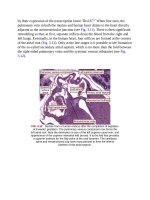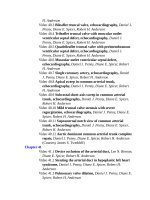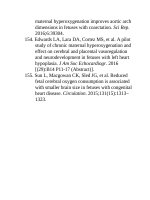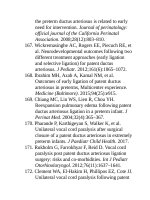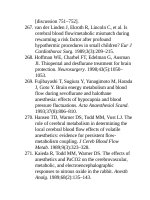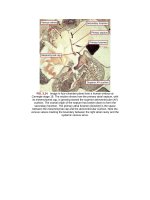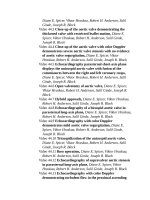Andersons pediatric cardiology 1840
Bạn đang xem bản rút gọn của tài liệu. Xem và tải ngay bản đầy đủ của tài liệu tại đây (62.02 KB, 3 trang )
Thepressurewaveformsthemselvesarevaluablesourcesofdata.Inarterial
tracings,theslopeoftheupstrokecanbeusedtogenerallyassesscontractility.A
steepupstrokeindicatesadequatecardiaccontractility,whereasablunted
upstrokemayindicatepoorcontractility,aorticvalvedisease,orperipheral
vasoconstrictionfromvasoactivedrugs.Thepositionofthedicroticnotchofthe
ventricularend-systolicpressureisanimportantindicatorofperipheralvascular
resistance.Alownotchindicateslowsystemicvascularresistance(SVR)and
canbeausefulclinicalindicatorinaneonatewithapatentarterialduct.
Significantrespiratoryvariationinthearterialwaveformmayindicate
hypovolemia.Finally,oneofthemostimportantindicationsforplacementofan
invasivearterialcatheteristheneedforaccurateassessmentofthepulsewidth.
Awidepulsewidthinthepreoperativeneonateisanimportantindicatorof
diastolicrunoffintothepulmonarycirculationandmaybeanearlyindicatorof
inadequatesystemicbloodflow.Thereliabilityoftheseinvasivedatais
improvedbytheuseofacentralarterialcatheterasopposedtothenoninvasive
assessmentofbloodpressure.
Anotheradvantageofanindwellingcatheteristheabilitytodrawblood
samplesforseriallaboratorymonitoring.Thisisparticularlyusefulforpatients
inwhomthereisconcernforanevolvingdeficiencyinDO2.Forexample,the
developmentofametabolicacidosisorariseinserumlactatelevelsmaybean
earlyindicatorofinadequateDO2.Inneonatesrequiringdiuretictherapy,an
indwellingcatheterallowsforthedailyassessmentofserumelectrolytesand
saferintravenousreplacementofanyderangements.Indwellingcentralvenous
cathetersalsoallowfortheadministrationofparenteralnutrition.
PeripheralVascularLine.
Itisimportanttoconsiderthatthemajorityofpreoperativeneonateswitha
fUVHmaybemanagedadequatelywithaperipheralintravenouslineratherthan
anindwellingcentralvenouscatheter.Theperipheralcathetercanbeusedto
administerinfusionsofPGE1andlow-concentrationglucose.Peripheral
intravenouscatheterscarrylowinsertioncomplicationratesandminimizethe
riskforthromboembolism,vascularocclusion,andinfectioncomplications.
PulseOximetry.
ContinuouspulseoximetryisutilizedinallneonateswithafUVH.Theprobeis
oftenplacedonthedistalextremity.InpatientswithfUVHwithanatomic
obstructiontosystemicbloodflow(seeChapter69),a“preductal”and
“postductal”saturationmeasurementistypicallymonitoredbyaprobeonthe
righthandandeitherfoot.
NearInfraredSpectroscopy.
Anearinfraredspectroscopy(NIRS)probeisusedinmanycentersasa
surrogatemeasureoftheadequacyofDO2.31,32Theprobeisattachedwitha
noninvasiveself-adhesivepadappliedtotheforehead,abdomen,and/orlumbar
area.33Itemitslightinthenearinfraredspectrum,whichisthenmeasuredby
sensorsatspecificdistancesfromthelightsource.Oxyhemoglobinand
deoxyhemoglobinhaveuniquepeakabsorptioninthenearinfraredspectrum.
Totalhemoglobinconcentrationismeasuredbytheabsorbanceoflightat800
nm.Analogoustothecalculationofsystemicsaturationbythepulseoximeter,
theNIRSmonitorreportstheratioofoxyhemoglobintototalhemoglobin
concentration.Thisvalueisoftenusedasasurrogatefor“mixedvenous”
oxygensaturation.CommerciallyavailableNIRSdevicesuseproprietary
algorithmstosubtractoxygensaturationfromoverlyingtissuesuchasbone.Itis
alsoimportanttonotethatNIRSdoesnotdistinguishbetweenarterialand
venousblood.Owingtotheselimitations,theNIRSmonitorisusedprimarilyas
anadjuncttootherindicatorsofcardiacoutput.
NovelNoninvasiveAlgorithmsBasedonHigh-FidelityContinuous
PhysiologicData.
Increasingnumbersofcentersnowemploysolutionstolinearlydisplayhighfidelitycontinuousphysiologicdataatthepatient'sbedside.Thesesystemsare
capableofpresentinginasinglelongitudinalviewanycontinuousphysiologic
datastreamconnectedtothebedsidemonitor.Continuousdatainputsinclude
heartrate,respiratoryrate,arterialandvenouspressures,pulseoximetry,
temperature,ventilatordata,andmedicationinfusiondata.Thesedataare
typicallydisplayedat5-secondintervals.Modernsystemsarealsocapableof
overlayingserialpertinentlaboratorydata(includingbloodgasandlactate
levels)onthephysiologicdatastreams.Longitudinaldisplayscanbeusedto
quicklyvisualizeimportantclinicaltrendsinpre-versuspostductaloxygen
saturations,bloodpressures,andpulsewidth.
Continuousdatastreamshaverecentlybeenusedtodevelopcomplex
mathematicalalgorithmstodetecttheriskforinadequateDO2.Onesuch
algorithm,theiDO2index,approvedbytheUSFoodandDrugAdministration,
usesphysiologicdatastreamstodisplaytheprobabilityofthemixedvenous
saturationbelow40%andthusinadequateDO2.Thisalgorithmwasvalidatedin
alargecohortofneonateswithafUVHandamultidistributioncirculation.A
sustainedperiodwithaniDO2indexbelow40%hasbeenassociatedwithan
increasedincidenceofcardiacarrestandaprotractedstayintheCICU.
Electroencephalography.
ContinuousEEGmonitoringmayprovideinformationoncorticalbrainactivity.
InstandardEEGmonitoring,leadsareplacedoverregionsoftheskull,anda
cartwithaCPUandvideocameraisplacedatthefootofthebed.Changesinthe
electricaltracingsarecorrelatedwithabnormalmovementsorchangesinvital
signs.PreoperativeEEGmonitoringisnotroutinelyundertakeninmostcenters
unlessthereisspecificconcernforastructuralbrainabnormality,genetic
syndrome,orclinicalseizure.
PhysiologyandPresentationofShockinthe
NeonateWithaFunctionallyUniventricularHeart
NeonateswithafUVHandhypoplasia/atresiaofthesystemicAVvalveand/or
ventricleaswellashypoplasia/atresiaoftheaortavalve(seeChapter69)may
developandgrowadequatelyinutero;followingbirth,however,theirsystemic
bloodflowisdependentonapatentarterialductandunobstructedsystemicand
pulmonaryvenousreturn(seeChapter70).Inthecurrentera,withtheadventof
fetalechocardiographyandtheincreasingprevalenceofprenataldiagnosis,
manyneonateswithafUVHaredeliveredfollowingaprenataldiagnosiswith
informedfamilies,physiologicstability,34,35andanexpectantcardiovascular
team.However,therearestillneonateswhoarenotdetectedprenatallyand,as
thearterialductconstricts,thereissystemichypoperfusionwitharelative
increaseinpulmonarybloodflow.36Clinicallythispresentsastachypneaand
poorfeeding,progressingtolistlessnessandfinallycardiovascularshock.The
clinicalpresentationmimicssepsisandtheonusontheclinicianistohaveahigh
indexofsuspicionforCHD.37Onlaboratorytestingthereisprofoundmetabolic
acidosiswithanelevatedlactateandend-organdysfunctionwithelevated
hepaticenzymesandcreatinine.
ShockoccurswhenoxygendemandexceedssystemicDO2.Inthisinstance,
